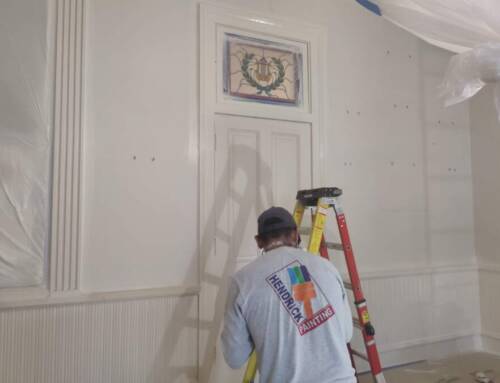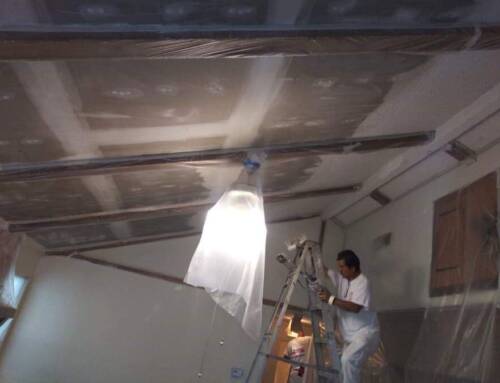GREEN PAINTING TIPS – 10 ECO-FRIENDLY PRACTICES

IN RECENT YEARS the average person’s knowledge of environmental issues has increased dramatically. Increased news coverage coupled with social media campaigns has brought heightened awareness to vital ecological issues. This increased awareness has led to a wave in the production of electrical and hybrid vehicles, using reusable bags at the grocery store, fast food chains opting to use biodegradable straws instead of their plastic counterparts and the list goes on. Most cities and townships have established policies that require building contractors to use eco-friendly materials and equipment in various phases of a construction project.
Green is no longer a word that simply represents a color. It has become a catch-all term to characterize any number of environmental initiatives. The hashtag #gogreen is trending high on all social media platforms. Now, people think about their carbon footprint and look for ways that they can reduce their negative impact on the environment without inconveniencing their lives unduly. There is a desire to strike a good balance between practicality and ecological responsibility.
Even though people typically think of paint as a harmful chemical the reality is there are eco-friendly paints out there and really many things that can be done to make any painting project kinder to the environment and your family’s health. In this post, we will examine just a few ways that this can be done. This is by no means an exhaustive list and we would encourage you to do your own research before planning your next project.
10 GREEN PAINTING TIPS
- Use VOC FREE or low VOC paints
This is perhaps the most obvious. VOCs are Volatile Organic Compounds and they can be harmful to your health. Although many interior paints are a little lower in VOCs, if your primary concern is health, go with a VOC FREE paint. If you plan to have good ventilation and don’t have the budget for these paints, go with low VOC paint. Typically, latex paint has a much lower level of VOCs than alkyd, as do flat compared to glossy.
- Don’t Waste Paint
This may not be so obvious. Leftover paint is a huge problem across the US. Check with your neighbors or your own garage before you pay for new paint and see what you already have available to you. Leftover paint can be used for touch-up jobs, smaller projects or as a primer. Also, before you buy new paint, calculate carefully how much you will need so there will be no waste. Normally 1 gallon will cover 350-400 square feet. Also, doing this has the added benefit of saving you a bit of money as well. And remember, you don’t need as much paint if you plan to use a primer.
- Recycle Your Empty Paint Cans
Don’t put unwanted leftover paint that is still liquid in the garbage. Take paint, stain, and varnish to a county household hazardous waste drop-off site. If the can is empty and/or the paint is dry ask if your recycling service provider accepts empty metal paint cans. In San Antonio, you can drop off at a household hazardous waste location, or you could reuse it for potting small plants. You can dry out small amounts of latex paint (less than 1 inch left in the can) in a well-ventilated area. Simply remove the lid to let the paint dry out. Stir occasionally to speed up the process or add kitty litter to help absorb moisture. Then you can peel it out and reuse it for another purpose.
- Properly Dispose of Hazardous Chemicals
Paint is not permitted in the garbage because it is a liquid. Oil paint is a hazardous waste. The same is true of thinners, and solvents. So make sure you take this to a household hazardous waste drop off. Never put these in the garbage! If you choose to keep it, store it safely. Ask your neighbors if they have need of these items if you do not intend to use them.
- Plan with the Weather in Mind
A dry day is best for indoor painting as well so that you can open windows and ventilate the rooms to minimize the chemical vapors you’ll be breathing. Follow the shade when you apply house paint your home’s exterior for a more durable coating. Schedule painting for a time when no rain is predicted to fall until at least 8-10 hours after completion of the job.
- Plan Longterm When Painting
This has the green effect of reducing the amount of material you use over time. Buy quality house paint and never apply it to a dirty, damaged, rough, or wet surface. Prepare for indoor painting by using a broom to sweep away dust and hard-to-reach cobwebs; then wipe the walls with a damp cloth. Outdoors, a hose is the best tool for cleaning walls and trim; do not use a pressure washer, which can damage the wall surface. Repair moisture problems, roughness, cracks, or holes.
- Milk Paints
Milk paint uses a protein called casein to keep the paint solution and pigment together rather than using harmful compounds. Milk paint is somewhat limited in terms of colors, but if you don’t mind a little trial and error to find the perfect shade, mixing colors together will significantly widen your options. Keep in mind that milk paint comes in powder form—once it’s mixed into a solution, you’ll need to complete your painting job the same day.
- Paints from Natural Minerals, Plant Dyes, and Resins
These natural paints are made from plant-based materials, essential oils, minerals, and natural dyes. If you choose a water-based natural paint, you most likely won’t detect a smell as you paint. Oil-based natural paints may carry the scent of the plant oils used in the solution. As with milk paints, be prepared to play a little to find the exact shade you’re looking for.
- Purchase or Borrow Good-Quality Supplies
The better quality the brushes and rollers you use, the better your paint job will look.
Pro painting supplies are usually intended for many years of use, so as long as you take care of them (don’t let the paint dry on the brushes or rollers, in other words), you won’t need to repurchase supplies the next time a painting project comes up.
- Try Recycled Paints
This is not the same thing as reusing old paint laying around the garage. These paints are reprocessed surplus paint collected from businesses, government offices, and residences. Although the quality is comparable to that of new paint, it comes at a lower price point. Recycled paint does contain a certain level of VOCs, so it is better for exterior jobs or for interior areas that are well-ventilated. Another benefit is it contains over 80 percent post-consumer material, using recycled paint makes you eligible for LEED credits.





